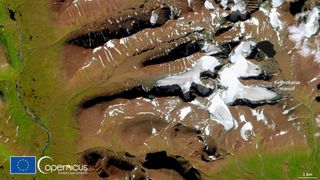Sweden's tallest mountain is shrinking from climate change
The melting of the Kebnekaise glacier is clear evidence of the progressing climate change, according to scientists.

Sweden's highest mountain peak shrunk by 6 and half feet (2 meters) in one year due to the melting of the glacier that covers it, a new study has found.
The Kebnekaise glacier, captured in an image by the European satellite Sentinel 2 on July 28, has lost one third of its mass in recent years due to climate change, according to a statement by the European Copernicus Earth observation program, which manages the Sentinel Earth observation constellation.
Measurements of the Kebnekaise mountain started in the 1940s, according to the Bolin Centre for Climate Research of Stockholm University, Sweden, which is in charge of the monitoring. Those observations show that the height of the mountain's southern peak varies throughout the year due to snow drift and the recession of ice in summer. It is usually at its highest in May and lowest in mid-September. The difference between the winter and summer height could amount to up to two or three meters.
When the university's geologists measured the mountain's height on Aug 14, they found it was at its lowest since the measurements began. At 6,872 feet above sea level (2,094.6 meters), the summit's altitude was nearly 6.6 feet (2 m) below the Aug 2020 value of 6,878.3 feet (2,096.5 m). The summit will likely lose at least further 1.6 feet (0.5 m) by mid-September, the scientists added.
Related: Record temperatures, fire clouds and drought ravage Earth in 2021
"The height variation is a good symbol of the glaciers' response to a warming climate in Sweden," Per Holmlund, professor of glaciology at the Bolin Centre's Tarfala Research Station who led the measurements, said in the statement. "When hikers climb the top today, they pass a flat part — a 'pre-peak' — which did not exist in the early 2000s. Since 2020, the peak is 2,2 meters (7.2 feet) lower, but the 'pre-peak' has grown by up to 1,2 meters (3.3 feet)."
Get the Space.com Newsletter
Breaking space news, the latest updates on rocket launches, skywatching events and more!
Average air temperatures in the region have been rising, according to the scientists, causing the ice to melt at a higher rate. The effect on the southern peak of Kebnekaise has been further exacerbated by changing wind patterns, which affect the accumulation of snow in winter.
The southern peak of Knebnekeise used to be Sweden's highest summit. But now this title has officially gone to the mountain's northern peak, which is more rocky and therefore resistant to the changing climate.
The melting of glaciers was mentioned in a damning report released by the Intergovernmental Panel on Climate Change (IPCC) earlier this month as one of the undisputed signs of the worsening climate change. The report described the rate of glacier loss as "unparalleled" in the past 2,000 years and predicted that the disconcerting trend will continue for centuries to come.
With their unobscured view from above, satellites help scientists monitor glaciers and ice sheets arounds the world and uncover the effects of climate change. The European Union’s Copernicus Earth observation program currently manages a constellation of nine Sentinel satellites that monitor various aspects of Earth’s environment.
Follow Tereza Pultarova on Twitter @TerezaPultarova. Follow us on Twitter @Spacedotcom and on Facebook.
Join our Space Forums to keep talking space on the latest missions, night sky and more! And if you have a news tip, correction or comment, let us know at: community@space.com.

Tereza is a London-based science and technology journalist, aspiring fiction writer and amateur gymnast. Originally from Prague, the Czech Republic, she spent the first seven years of her career working as a reporter, script-writer and presenter for various TV programmes of the Czech Public Service Television. She later took a career break to pursue further education and added a Master's in Science from the International Space University, France, to her Bachelor's in Journalism and Master's in Cultural Anthropology from Prague's Charles University. She worked as a reporter at the Engineering and Technology magazine, freelanced for a range of publications including Live Science, Space.com, Professional Engineering, Via Satellite and Space News and served as a maternity cover science editor at the European Space Agency.
